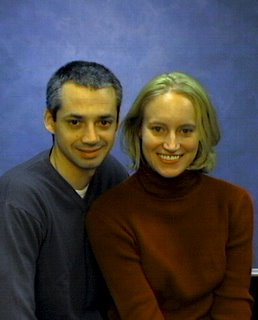
About three blocks from our apartment is a large garden and the Palais Longchamp. The garden is quite popular for kids and families to play on the playgrounds, ball games, pony rides, carousel, etc. It used to be a zoo, but the animals were removed some years ago due to noise. The Palais is actually a folly with two large wings, housing the Natural History Museum and the Fine Arts Museum, closed for renovations. 
From wwww.marseille-tourisme.com:
This historic building, inaugurated in 1869, commemorates the arrival of
the water of the canal between the river Durance and Marseille. On the same site, it brought together the Museum of Fine Arts, which before was in the former Bernadines chapel, the Museum Natural History, a botanic park and a zoo. The rich decoration of the building evokes the abundance and fertility brought 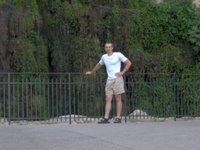 by the water of the canal. Here sculpture has a dominating role, and this work was entrusted to the greatest artists of that period. The famous animal sculptor Antoine Louis Barbye created the lions and the tigers of the entrance, and the monumental fountain in the centre of the row of columns is the work of Jules Cavelier. It represents the river Durance surrounded by figures symbolizing the vines and wheat on a cart pulled by the bulls of Camargue.
by the water of the canal. Here sculpture has a dominating role, and this work was entrusted to the greatest artists of that period. The famous animal sculptor Antoine Louis Barbye created the lions and the tigers of the entrance, and the monumental fountain in the centre of the row of columns is the work of Jules Cavelier. It represents the river Durance surrounded by figures symbolizing the vines and wheat on a cart pulled by the bulls of Camargue.
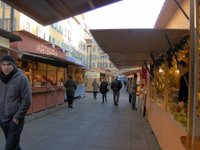
 Today at school, we had one of our free outings. We went to the Foire Aux Santons, or market. We left at nine, but it didn't open until 10, so we had a coffee at the Vieux Port. There were six students and one of the teachers. There were about 20 stalls, all with very similar santons, different sizes.
Today at school, we had one of our free outings. We went to the Foire Aux Santons, or market. We left at nine, but it didn't open until 10, so we had a coffee at the Vieux Port. There were six students and one of the teachers. There were about 20 stalls, all with very similar santons, different sizes.Santons are clay figurines that come either painted, or unpainted (less expensive). They come in many different sizes (small painted ones about 7 euros each), and some have real clothes, and other real implements. These can be a hundred dollars or more. Many of them are the traditional Nativity figurines, plus the butcher, the baker, and the candlestick maker.
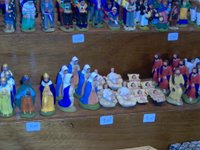
Betchya didn't know they were at the birth of Jesus did ya?
For more information on Santons
History of Santons
http://www.beyond.fr/themes/santon.html
More Santon examples.
http://www.simplytreasures.com/

This is the cathedral/basilica built on top of one the highest hills in the middle of Marseille. The views from the cathedral are spectacular- one can see all of Marseille. It used to be where the lookout post was. A chapel was built on the hilltop in the 13th century, and became a priory for the monks of St Victor. In the 16th century, the church was fortified, to defend against a threatened invasion by Charles V of Spain. It was built between 1853 and 1864. (side note- the foundation stone was laid September 11th) On top of the belfry is a huge golden statue of the Virgin holding a child. From Wikipedia:
The interior is decorated with inlaid marble, mosaics and murals. On the walls, there are many plaques from sailors and their families, sometimes just saying Merci. There are also hanging from the ceiling many small model boats.This ornate Neo-Byzantine church sits atop the signal hill of La Garde, the highest natural point in Marseille, being a 162 m (532 ft) limestone outcrop on the south side of the Vieux Port. As well as being a major local landmark, it is the site of a popular annual pilgrimage every August 15th (Assumption). Local inhabitants commonly refer to it as "la bonne mère (the good mother)." The basilica took five years to build and required 170,000 tons of material, including 23 shiploads of marble and
porphyry from Italy.
An ex-voto is a votive offering to a saint or divinity. It is given in fulfilment of a vow (hence the Latin term, short for ex voto suscepto, "from the vow made") or in gratitude or devotion. Ex-votos are placed in a church or chapel where the worshipper seeks grace or wishes to give thanks. Shrines decorated with ex-votos are often the destinations of pilgrimages. Ex-votos can take a wide variety of forms. In the church of Notre-Dame-de-la-Garde in Marseille, France, the site of a major local pilgrimage, the ex-votos include paintings, plaques, model boats, war medals and even football shirts given by players and supporters of Olympique de Marseille, the local team.
(side note: Allez l'OM! Droit au but!)
Our Lady of the Guard belongs to all the inhabitants of Marseille. "Our Good Mother" pays particular attention to the people of the sea: she looks out to sea and the port entrance.
And finally, because every Cathedral needs to have a website
From the article "Marseille's recipe for composure" sent to me by Genevieve.
This scruffy port has most of the ingredients associated with the recent rioting and car burning in French cities: high unemployment, a huge immigrant community, considerable poverty. Yet Marseille emerged relatively unscathed compared with cities like Paris, Toulouse, and Lyon.'Everyone in France speculated that Marseille would be the first to burn. You need to live here to understand why it did not.' Residents insist that Marseille is different from other large urban centers in France. They have centuries of experience in managing immigration, they say - 2,600 years in total, if you count back to the city's founding by Greek traders. Marseille, the second largest city in France, is French the way New York is American: The city is defined by the waves of immigrants who settled here, chief among them Italians, Armenians, and Muslims and Jews from Algeria, Tunesia and Morocco....Personally, I'm not sure how un-racist Marseille is, I think it depends on where you come from. I, as a blond-haired blue-eyed American, feel that most likely I get treated differently than an African woman wearing a head scarf. But in general I think people are pretty relaxed and willing to help, even if they can't understand what I am asking for half the time in grocery store.
It is impossible not to notice the diversity of this city. In one glance across the sidewalk here you can spot West Africans selling handicrafts, crusty French seamen emerging from the port, and French-Arab youths in track suits strutting into a fast-food joint.
Fraise! Fraise! Small, round, red, fruit?
Sorry, I don't understand.
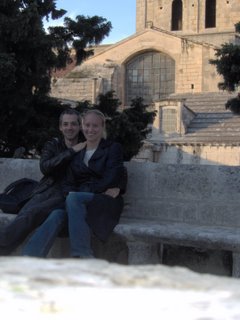
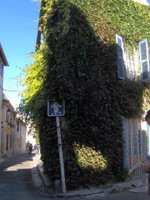 The next morning we woke up, had breakfast at a café- coffee and croissants. You can buy croissants at bars or at bakeries. If it is at all possible, buy them at a bakery and then go to the bar to eat them with your coffee.
The next morning we woke up, had breakfast at a café- coffee and croissants. You can buy croissants at bars or at bakeries. If it is at all possible, buy them at a bakery and then go to the bar to eat them with your coffee.We walked around in the early morning, it was quite beautiful
 with the light on the old stone buildings. We walked along the river and went to the Museon Arlaten. As it was the first Sunday of the month, it was free. Apparently the museum was founded by Frédéric Mistral using his Nobel Prize money in 1904, renovating a 16th century building. It was a very interesting museum, with tons of old portraits, costumes, household items, etc. It also has information about local customs, folklore, and traditions. The guides were dressed in traditional costume and apparently very eager for us to leave so they could go to lunch.
with the light on the old stone buildings. We walked along the river and went to the Museon Arlaten. As it was the first Sunday of the month, it was free. Apparently the museum was founded by Frédéric Mistral using his Nobel Prize money in 1904, renovating a 16th century building. It was a very interesting museum, with tons of old portraits, costumes, household items, etc. It also has information about local customs, folklore, and traditions. The guides were dressed in traditional costume and apparently very eager for us to leave so they could go to lunch.Afterwards, we checked out of our hotel, had lunch, and walked around Arles further before going to the Musée de l'Arles Antique. This Museum used to be located in the old part of the city, but was recently moved to a huge building. It had many artifacts from Ancient Arles, mostly concerning the Roman period. There were huge mosiacs, sarcophagus, statues, and household implements. We didn't have much time as I would have liked since the museum was closing. Then we drove home. It was a great weekend.

For my birthday and our two year anniversary (the day after), Alain and I decided to spend a weekend in the nearby city of Arles. It is about an hour away by tollway, to the northwest.
Here is the description from the guidebook.
Few other towns in Provence combine all the region's charms as well as Arles. Its position on the Rhône makes it a natural, historic gateway to the Camargue. Its Roman remains, such as the arena and Constantine's baths, are complemented by the ocher walls and Roman-tiled roofs of later buildings. A bastion of Provençal tradition and culture, its museums are among the best in the region. Van Gogh spent time here in 1888-9, but Arles is no longer the industrial town he painted. Visitors are now its main business, and entertainment ranges from the Arles festival to bullfights.
We left Saturday morning and arrived a little before noon. It was a challenge to find our hotel, as the roads in the old section (within the Roman walls) are very narrow, one way and winding. We finally managed to find it, checked in, and went to eat lunch. Our hotel was very close to the Amphitheater. After lunch, we set off to explore the city.
First we went to the Amphitheater. It is described as one of the best-preserved monuments of  Roman Provence. It is 446 ft by 351 ft, and could seat 21,000 people. "The floors of some of the internal rooms were decorated with mosaics, the better to wash down after bloody affrays." Those Romans, they think of everything. Interesting point- the arena is the actually sandy area in the middle, the surrounding part is the Amphitheater. In summer they hold Bullfights, some where they kill the bulls, others not. It is free for residents of Arles, and there were some in there reading books, like at a college campus. Today I think I will go read my Statistics book in a 2000-year old monument....
Roman Provence. It is 446 ft by 351 ft, and could seat 21,000 people. "The floors of some of the internal rooms were decorated with mosaics, the better to wash down after bloody affrays." Those Romans, they think of everything. Interesting point- the arena is the actually sandy area in the middle, the surrounding part is the Amphitheater. In summer they hold Bullfights, some where they kill the bulls, others not. It is free for residents of Arles, and there were some in there reading books, like at a college campus. Today I think I will go read my Statistics book in a 2000-year old monument....
After, we went to see the Cloisters of St-Trophime. Not sure really what it was. I think a  monastery. Not much in the way of explanations. All signs in French museums are in French. No English or any other language for other visitors. Anyway, there was an exposition of UNESCO World Heritage site pictures, of all former Roman cities and monuments. Right outside in the Place de la Republic is the city hall, a huge Egyptian Obelisk, and the Eglise St-Trophime. It is a "fine Romanesque church" with a 12th century portal of the Last Judgement, including saints and apostles.
monastery. Not much in the way of explanations. All signs in French museums are in French. No English or any other language for other visitors. Anyway, there was an exposition of UNESCO World Heritage site pictures, of all former Roman cities and monuments. Right outside in the Place de la Republic is the city hall, a huge Egyptian Obelisk, and the Eglise St-Trophime. It is a "fine Romanesque church" with a 12th century portal of the Last Judgement, including saints and apostles.
The rest of the day we just walked around, tried to find some place to eat. We finally found a  place called L'Escalade, close to the amphitheater. It said that it opened at 6:30. Whenever you find a restaurant that says that, don't believe them. They are lying. Technically, there might be someone there at that time, but they are not open and not ready to serve food. Me, I was hungry at 6. We waited until 6:45 to arrive. They let us in, but boy did we feel in the way. We returned to the hotel and fell asleep immediately.
place called L'Escalade, close to the amphitheater. It said that it opened at 6:30. Whenever you find a restaurant that says that, don't believe them. They are lying. Technically, there might be someone there at that time, but they are not open and not ready to serve food. Me, I was hungry at 6. We waited until 6:45 to arrive. They let us in, but boy did we feel in the way. We returned to the hotel and fell asleep immediately.
Example: Je mange la pomme. (I eat the apple.)
Je la mange. (I eat it)
In the passé composée form it gets interesting. Since apple is the direct object, the ending of the verb has to accord with it.
Je l'ai mangée.
But if there is no direct object, such as I ate yesterday, it is just
J'ai mangé hier.
It can be difficult to guess what gender the noun is, as there doesn't seem to be any logical assignment of the gender.
lipstick : le rouge à lèvres
tampon: le tampon
(side note: tampon can also be stamps, which leads for some interesting store signs. Kind of like the Supermaxi grocery store in Ecuador.)
The passé composée verbs can be conjugated with être (to be) or avoir (to have). When I took Intro to French back at UVA, I mistakenly thought that it was a direct translation of english, such as
Je suis entrée (I was entering)
But no, it is entered. Note the extra e at the end of entrée when a woman is speaking.
For a man: Je suis entrée.
For we: Nous sommes entrés (for a mixed gender group)
but for a group of women: Nous sommes entrées.
It can be very confusing sometimes. Especially as you cannot hear the difference in the pronounciation, only can guess by the context and who is talking. Same as with the 3rd person singular he/she il/elle, and the 3rd person plural they ils/elles, many times, but not always, the verb endings sound the same.

Lançon-de-Provence is a small town about 30 minutes north west of Marseille. Lancoun De Prouvenco in the old Provencal language. It i s very cute, my idea of what a perfect Provençcal village should be like. I am sure there are nicer ones, but not "real" ones. It also happens to be where Alain's parents live, where he grew up, and where we will be getting married.
s very cute, my idea of what a perfect Provençcal village should be like. I am sure there are nicer ones, but not "real" ones. It also happens to be where Alain's parents live, where he grew up, and where we will be getting married.
http://www.provenceweb.fr/e/bouches/lancon/lancon.htm
The website states that there are 6,786 inhabitants. There is a small church, where we will be getting married, plus another small chapel. Correction, where the marriage blessing will take place. You can only get "married" one place, and that is the city hall. The surrounding countryside has olive trees and grape vines. Alain's parents have a fig tree, a cherry tree, and two olive trees. One thing that I love about the french language is the names for the trees- le olivier, le figiuer, and le cerisier. All of the houses are built out of brown sandstone? rocks? and the shutters are painted bright colors, blues, purples, pinks, reds, browns. There are several boulangeries (bakeries, required, I really do believe it is a law stating for X numbers of inhabitants you have to have Y number of bakeries), pizza places, coiffures, war memorials, and so on. Many of the streets are cobblestoned and narrow. You can walk everywhere in the village.
The surrounding countryside has olive trees and grape vines. Alain's parents have a fig tree, a cherry tree, and two olive trees. One thing that I love about the french language is the names for the trees- le olivier, le figiuer, and le cerisier. All of the houses are built out of brown sandstone? rocks? and the shutters are painted bright colors, blues, purples, pinks, reds, browns. There are several boulangeries (bakeries, required, I really do believe it is a law stating for X numbers of inhabitants you have to have Y number of bakeries), pizza places, coiffures, war memorials, and so on. Many of the streets are cobblestoned and narrow. You can walk everywhere in the village.
There are the ruins of a chateau from the 17th century, the Lords of Baux. It is now split up into many little houses, built into the walls. Unfortunately, the area is becoming expensive, beh oui.

Our apartment is located in the 4eme arrondisment, which is like a district of the city. Major cities are broken up into arrondisements, with the 1st being the center of town, and radiating out from there. It is a pretty good area, with parks and museums, and close to the center. It takes about 30 minutes to walk to my school which is in the center, which I have done several times due to the Metro strike. But that is another post for another time.
The apartment is located on a main street, one block from a metro station, with several bakeries/patisseries, general food and vegetable stores, a video club next door, the post office across the street, on the bus line, etc. Parking is a problem, as most of the buildings do not have underground parking, and there aren't a lot of empty parking lots. So mostly it consists of driving around and trying to find some empty sidewalk to park on. But that is also another post for another time, which will probably be entitled "Imaginative Parking" accompanied by pictures.

The building is over 150 years old. No big deal. The walls are thick and the ceilings are 3m high. We have wooden shutters on the windows to be closed and opened every day. You have to be careful to fasten the shutters so that the wind doesn't rip them off. Since the buildings were built before electricity and plumbing, when the lines were put in they just drilled holes from floor to floor and room to room, so everything is visible. The floor is a mixture of brick red 6 sided tiles, (as in picture) and newer white square tiles. We have an electric radiator in every room, which is starting to become necessary now.
On the ground floor there is a florist shop and a CousCous restaurant. The main entryway has all the mailboxes- for incoming mail only. All outgoing mail has to be put in a mailbox. In the back is kind of a common area for storage, hanging clothes, etc. There is a spiral staircase winding up the center, with all of the stairs tilted in towards the middle of the staircase. I heard that they are tilted because over the years housewives would throw out their mop water and it would cascade down the stairs, eventually wearing away one side, but I don't know if that is true or not. There are two apartments per floor. We live on the third floor, on the right. Sometimes this is noted on our address. "Troisieme etage, a droit". Correction, we live on the third floor, in french. In english, it would be considered the fourth floor. So
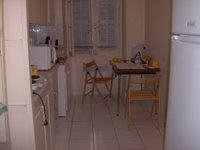 all together, there is the ground floor, four floors with people living on them, and one top floor with more storage space.
all together, there is the ground floor, four floors with people living on them, and one top floor with more storage space.Our kitchen is quite narrow. It came with no stove, and no refrigerator. Alain bought a refrigerator before I arrived and moved it in. So glad I wasn't here for that! The bathroom is quite large, with a sink and bathtub. The toilet is in another seperate room, as in many french households. Quite useful actually, as most places only have one bathroom. We have ten shelves. Alain's stuff takes up one shelf. We have towels on one shelf. The other eight shelves are mine.

Hmm, what else can I say about it? No laundry machines. Have to go down the block for that, to the little laverie that has all of two washers working and one dryer working, the change machine that doesn't work, and might be going out of business. A lot of people don't use the dryers as they just hang everything out the window. It is pretty soundproofed. Or perhaps the people above and next to us are quiter than normal. The house across the back from us is quite irritating as their terrace is slightly lower than our apartment. In summer it was worse because we had to have the windows open, no air conditioning Bien sur, and they were having late parties.
If anyone has any questions about it, please feel free to ask them in the comment section.
After we went back and had dinner at a little restaurant, called Le Mange-Tout. I tried pastis for the first time, and didn't like it very much. It is a very typical Provencal achololic drink, made with licorice flavors and star anise (badiane), anethol, various herbs, alcohol and water. "Ne perdez pas le sud"- Don't lose the south, is the advertising slogan for one of the brands. We also had little small fried fish, Mangetouts I think, for an appetizer.
Here is the description of Les Calanques from the guidebook Provence & The Cote D'Azur
Between Marseille and Cassis the coast is broken up by calanques - enticing fjord-like inlets lying between vertical white cliffs, some 400 m high, drop vertically into the tempting blue water. Continuing deep under the blue waters, they offer safe natural harbours and fascinating aquatic life, with glorious view from the high clifftops. Their precipitious faces provide a challenge to climbers. Pine and oak trees grow on the rocky slopes, home to woodland birds such as owls. Access to some inlets is by boat....

In 1991, a cave was found with its entrance 100 m beneath the sea at
Sormoiu. It is decorated with pictures of prehistoric animals resembling the ancient cave paintings at Lascaux in the Dordogne.

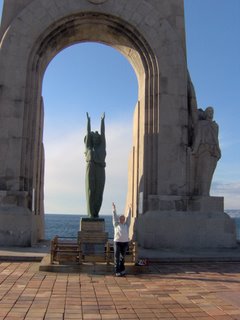 Yesterday afternoon Alain and I took the metro down to the Vieux Port. From there, we walked along the Corniche, along the edge of the sea. It was a beautiful day, bright and sunny, but a little windy. We walked to the Monuments aux Rapatriés, which we had driven by many times, but never stopped and looked at. I thought that it was some sort of "Gateway to the Sea", but it wasn't. It is a Memorial for the first World War.
Yesterday afternoon Alain and I took the metro down to the Vieux Port. From there, we walked along the Corniche, along the edge of the sea. It was a beautiful day, bright and sunny, but a little windy. We walked to the Monuments aux Rapatriés, which we had driven by many times, but never stopped and looked at. I thought that it was some sort of "Gateway to the Sea", but it wasn't. It is a Memorial for the first World War.Then we explored the area Vallon des Auffes, which is described as "A tiny picturesque fishing harbour with large boats and small boats with pointed bows (pointus), well known for its fish restaurants." It is very cute area, like a tiny fishing village inside a big city.
 I guess it is the kind of place where if you are lucky enough to have a house, you don't ever ever sell, you just pass it down to your descendants. The houses are tiny and there are no cars. From there we stopped at a cafe and had a hot chocolate, then walked back to the Vieux Port, and took the subway home.
I guess it is the kind of place where if you are lucky enough to have a house, you don't ever ever sell, you just pass it down to your descendants. The houses are tiny and there are no cars. From there we stopped at a cafe and had a hot chocolate, then walked back to the Vieux Port, and took the subway home.
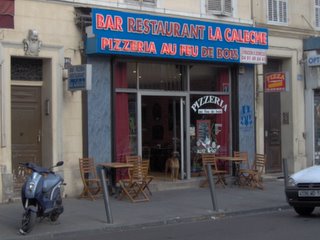
One thing that the Marsellais really love is Pizza. Even more so than Americans. Within five minutes of walking distance, there must be at least 20 pizza places. We have tried most of them (for purely scientifc statistical analysis purposes of course) and have found our favorite, Chez Cyril. Chez is a word that commonly means Place. It is used a lot for restaurants, but also means my place, chez moi, your place, chez toi, etc. In french the possessive 's is not used.
All are take-out/delivery. The prices are generally all between 7 and 10 euros. All small towns have at least one pizza place, and usually a pizza van too. The pizza vans like to park right by the Metro entrance, which is quite tempting when returning from school.
The picture above is of the first pizza place we tried. Okay, but not great. You can sit inside at the smoky bar if you want, or you can sit out on the street and watch cars go by. We decided to bring it home and eat.
Typical pizza- thin crust, not a lot of sauce, slightly burnt edge, cooked "feu de bois" (woodfire), with four whole black olives. You can order a plain cheese pizza, and you will still get the olives. You have to ask for them to not be put on if you don't want them. But they are very good.
Toppings are usually ham, spicy sausages, creme fraiche, mushrooms, onions, seafood, curry, eggs, herbs, chicken, and cheeses. This isn't your regular grated mozzarella cheese either, remember this is France. You can have goat cheese Chevre, blue cheese Roquefort, emmental, mozzarella, etc.
Most popular pizza- anchois. That's right, anchovies. The most feared pizza topping in the US is the number one choice here.
Besides pizza, you can order chaussons (like calzones), ice cream, sodas, biere, and of course wine.
For the Rouille, you take a piece of toasted french bread, rub it with garlic, then spread this Rouille paste on it. You place the bread in the fish broth, add grated Emmental cheese if you want, and eat. It was okay, pretty strong.
At karate last night, one of the ladies asked if I had celebrated Thanksgiving. I said No, not this year. Our kitchen is not properly equipped. It is really hard to do a turkey when all you have is two hot plates, a microwave, and a toaster oven. Perhaps next year, if we are not living in the same place. I guess a group of Americans (and their french spouses) are getting together today for a Thanksgiving meal. The french lady said she had tried the Tarte au Poitrions (pumpkin pie) and that she didn't like it. The french don't seem to like pumpkin pie. I think it is because they don't cook it right. They don't used the canned stuff for one. They also don't like cinammon, which means they are just plain crazy.
Here are the instructions for Rouille.
1 1/2 cups diced French bread, white part only
1/2 cup fish broth (reserve some from the making of bouillabaisses)
4 to 6 garlic cloves, to your taste, peeled
1 teaspoon salt
1/2 teaspoon ground red chili pepper
Pinch of saffron threads, crumbled
1 large egg yolk
Freshly ground black pepper to taste
1 1/4 cups extra virgin olive oil
5 tablespoons unsalted butter
40 to 50 slices French baguette bread (about 1 loaf)
1. Soak the diced bread in the fish broth. Squeeze the broth out. Mash the garlic cloves in a mortar with the salt until mushy. Place the bread, mashed garlic (saving 1 garlic clove for the croutes), red pepper, saffron, egg yolk and black pepper in a food processor and blend for 30 seconds then pour in 1 cup olive oil through the feed tube in a slow, thin, steady stream while the machine is running. Refrigerate for 1 hour before serving. Store whatever you don't use in the refrigerator for up to a week.
2. Meanwhile, prepare the croutes. In a large skillet, melt the butter with the remaining 1/4 cup olive oil over medium heat with the remaining crushed garlic until it begins to turn light brown. Remove and discard the garlic.
3. Lightly brush both sides of each bread slice with the melted butter and oil and set aside. When all the slices are brushed place them back in the skillet and cook until they are a very light brown on both sides. Set aside until needed.
Variation: Another way to make the croutes is to toast them first and then rub both sides with a cut piece of garlic.
Note: If the rouille is separating, add 2 to 3 tablespoons of the fish broth and whisk it in until smooth and re-emulsified.
Makes 1 1/4 cups sauce rouille and 10 servings of croutes
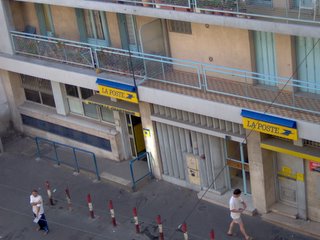
Going to the Post office is always an interesting study in communication.
Me: (pointing at box) "Boite"
Clerk: rapid stream of french.
Me: (to send) "Envoyer"
Clerk: (in french) To some foreign place?
(why do they always assume that? Do I seem foreign to them?!)
Heaven help me if I need to send something with insurance, to get a tracking number, or something out of the ordinary.
Tuesday I received a note saying I had a package, and to come pick it up. I went a little after they opened, got to the window and presented my slip. Oh no, we can't give that to you now, you have to come back after 10 am. Why, the packages are right in that room right there? Just because.
I return after ten and again present my slip. The clerk goes into the back, rummages around for awhile, and returns with a box, asking what my first name is. Megan.
The box was address to Dominque Schmidt, which even in French must be a long cry from Megan Smith. The address was completely different as well- street and number. I'm thinking there was no one by that name at that address, so they searched within a ten block radius to see who has a name even remotely similar. Sigh. And I was so excited about receiving a package too.
La Poste is where we have our bank account too. It is helpful in that it is right across the street and has an ATM. For any actual money transactions though (depositing checks, changing currency, etc) it might as well be non existent. Oh no, you can't change money here. You have to go to the larger post office. Sure, we can deposit that $50 American check for you. But it will cost $40 in fees. Getting my name added to the account was laughable as it took about 2 months to do it. We mistakenly made our first attempt in August, when all private companies are on vacation and the public services only pretend to work. They now have me listed on his account as M. Alain P____ and ith.
About Me
Blog Archive
Libellés
- 101 (13)
- Aix en Provence (13)
- Alain (22)
- Baby (11)
- Bureaucracy (14)
- Cooking (14)
- Daily Life (31)
- Dealing with the French (33)
- Entertainment (1)
- Ex-patness (14)
- Family (37)
- Food (1)
- French Customs (40)
- French Language (20)
- Friends (10)
- Fromage (14)
- Health (21)
- Hobbies (4)
- Holidays (29)
- Homesick (11)
- Jobs (10)
- July 22 (5)
- Marriage (1)
- Marseille (10)
- Me (3)
- Memories (3)
- Misc (40)
- Mishaps (16)
- Motorcycle (5)
- Music (2)
- Nationalité (3)
- Our Apartment (45)
- Overheard (2)
- parenting (2)
- Patents (24)
- Pictures (25)
- Provence (32)
- Ramblings (21)
- Random (1)
- Rants (30)
- Restaurants (1)
- Rugrats (7)
- S. (2)
- Scientific Stuff (4)
- Social Awkwardness (1)
- Sports (1)
- Strasbourg (13)
- Trips (52)
- VMI (12)
- Wedding (24)
- Wine (2)
- Wordless Wednesday (3)
Favorite Posts
-
The above cartoon for kids to color, cut out, and fold into a cube shape. Then the cube is to be placed in the center of the table for remi...
-
I picked up my French passport this morning. It has been ready for awhile, I received the text message saying it was available for pick-up a...
-
Here is the other cross-stitch I finished this year, this one is for Alain's Aunt, Lydia. I have now done at least one for every hous...
-
Come to an end. My maternity leave is ending and I return to work on Monday. Alain will then take his two weeks of paternity leave, then we...
-
you buy something from Sephora and get "premiér rides" (first wrinkles cream) samples. Sigh. Today is my birthday. The big 3-0. Su...
-
Someone had other plans. Our daughter S. decided to make her appearance weeks ahead of schedule. (We have decided not to post her full name,...
-
Got back from Strasbourg just fine. My wallet however, did not. After my long train trip back home, and being called "sale race" (...
-
One more month... More or less. One more week of work. I was actually supposed to stop February 4th (six weeks before D-Day) but now French...
-
I think I am entering the 'tired' stage of pregnancy. And no, not just physically tired. Tired of lying down, tired of sitting, tire...
